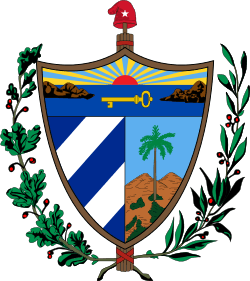Earl T. Smith
Earl Edward Tailer Smith (July 8, 1903–February 15, 1991) was a United States diplomat, ambassador to Cuba (1957–1959), mayor of Palm Beach (1971–1977), and husband of model Florence Pritchett Smith (1920–1965).
Biography
Smith was born in Rhode Island and studied at Yale University (1926–28) before becoming an investment broker and a member of the New York Stock Exchange. He also became a partner in the investment brokers, Paige, Smith, and Remick (1930–1939).
In 1941 U.S. President Franklin D. Roosevelt appointed Smith as special assistant in the Office of Production Management (later War Production Board). He left this post to serve in the United States Army during the Second World War. He served overseas and by the end of the war reached the rank of lieutenant colonel.
As a successful businessman, he became the finance chairman of the Florida Republican Committee.[1]
In June 1957, U.S. President Dwight Eisenhower appointed Smith ambassador to Cuba, replacing Arthur Gardner. Smith was a businessman who had never held a diplomatic position and who did not speak Spanish.[1] On arrival, Smith was urged by his staff to leave Havana in order to get a better feel of the country, which was in a state of some turmoil. On a visit to Santiago de Cuba, Smith witnessed first-hand the funeral and burial of Frank Pais, one of the leaders of the M-26-7 movement. After his death, well over 200,000 people attended the event, and that convinced Smith that something had to be done about the dictatorship of Fulgencio Batista. Smith was also critical of what he perceived as Washington's ambivalent attitude towards the growing 26th of July movement led by Fidel Castro, feeling that the CIA were underestimating the strength of the Communist Party of Cuba.[2]
Smith resigned his post on 20 January 1959, to be replaced by Philip Bonsal, three weeks after the Cuban Revolution led by Castro. In 1960 Smith testified to the Senate Committee on the subject of the "Communist threat to the United States through the Caribbean". During the hearings Smith said that "Until Castro, the U.S. was so overwhelmingly influential in Cuba that the American ambassador was the second most important man, sometimes even more important than the Cuban president."[3] He presented the lawmakers with the following options:
If we are to intervene sufficiently to bring about the overthrow of dictatorships, then we should intervene to whatever extent is required to fulfill our purpose. Otherwise, in my opinion, we must wait for the normal self-development of a people and not assist revolution. And we must be prepared to receive the criticism of supporting friendly governments recognized by the United States, although they have been labeled dictatorships. To make my point more clear, let me say that, we helped to overthrow the Batista dictatorship which was pro-American only to install the Castro dictatorship which is pro-Russian.
External Links
- Communist threat to the United States through the Caribbean Earl E. T. Smith evidence to the Senate Committee on the Judiciary on 27 August 1960.
- Inventory of the Earl E.T. Smith papers at the Hoover Institution Archives of Stanford University
See Also
References
- 1 2 Book Excerpt The Man Who Invented Fidel: Castro, Cuba, and Herbert L. Matthews of the New York Times
- ↑ Batista's Cuba Lyman B. Kirkpatrick, Jr. The Real CIA. New York: The Macmillan Company, 1968
- ↑ Ernesto "Che" Guevara (World Leaders Past & Present), by Douglas Kellner, 1989, Chelsea House Publishers, ISBN 1-55546-835-7, pg 66
| Diplomatic posts | ||
|---|---|---|
| Preceded by Arthur Gardner |
United States Ambassador to Cuba 1957-1959 |
Succeeded by Philip Bonsal |
